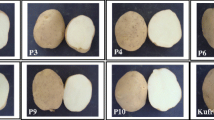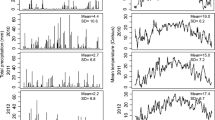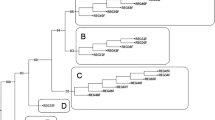Summary
The broad range of wild and cultivated species relatives of the commerical potato (Solanum tuberosum L.), guarantees the existence of a gene reservoir to be screened for traits that are absent or present only in low frequencies in the cultivated germplasm. Haploids (2n=2x=24) extracted from the cultivated tetraploid (2n=4x=48) germplasm cross easily with diploid (2n=2x=24) potato species and produce fertile progeny. As most haploid × species hybrids tuberize under long day conditions they can be maintained clonally and evaluated for the traits of interest. Three populations involving Tuberosum haploids × Solanum bukasovii (tub x buk), Tuberosum haploids × Solanum sparsipilum, (tub × spl) and Tuberosum haploids × Solanum berthaultii (tub x ber) clones, were planted at two locations in Wisconsin. The haploids were derived from W231, a selected clone from the University of Wisconsin Potato Breeding Program. The objectives were: to evaluate the H-S populations for agronomic and processing traits, and to determine the phenotypic associations between them. Data were recorded on haulm maturity (HM), tuber weight (TW) and tuber number (NT) per plant, specific gravity (SG), chip color after harvest (CH), and chip color after storage at 4° C and one week of reconditioning at room temperature (CH1). Results for SG and CH indicated good potential of the germplasm evaluated to introgress these traits into the commercial potatoes. For instance, the SG mean for tub x buk, tub x spl and tub x ber were 1.079, 1.086 and 1.082, respectively, and their means for CH were 4.8, 3.9 and 3.5. Chip color after storage and reconditioning was found in low frequency in the populations. Four clones in the tub x spl population, and three clones in the tub x ber population had CH1 ≤ 4.0, the commercially acceptable score for this trait. Significant (p ≤ 0.01) phenotypic correlations (r) were found between HM and SG (r=−0.46 in tub x buk, r=−0.61 in tub x spl, and r=−0.34 in tub x ber), NT and TW (r=0.79 in tub x buk, r=0.88 in tub x spl, and r=0.71 in tub x ber), and TW and SG (r=0.40 in tub x buk, and r=0.36 in tub x spl). The correlation coefficients between processing traits were not significant, which may indicate the presence of separate genetic mechanisms governing the inheritance of these traits.
Similar content being viewed by others
References
Carroll, C.P. & R.J. Low, 1976. Tuberosum dihaploids. Potato Res. 19: 109–121.
Cubillos, A.G. & R.L. Plaisted, 1976. Heterosis for yield in hybrids between S. tuberosum ssp. tuberosum and S. tuberosum ssp. andigena. Am. Potato J. 53: 143–150.
Dale, M.F.B. & G.R. Mackay, 1994. Inheritance of table and processing quality. In: J.E. Bradshaw & G.R. Mackay (Eds). Potato Genetics. pp. 285–315. CAB International, UK.
Dean, B.B., 1994. Managing the Potato Production System. Food Products Press, Binghamton, NY. 183 pp.
De Jong, H., G.C.C. Tai, W.A. Rusell, G.R. Johnston & K.G. Proudfoot, 1981. Yield potential and genotype-environment interactions of tetraploid-diploid (4x-2x) potato hybrids. Am. Potato J. 58: 191–199.
De Jong, H. & P.R. Rowe, 1971. Inbreeding in cultivated diploid species. Potato Res. 14: 74–83.
Gallais, A., 1990. Théorie de la sélection et amélioration des plantes. (Collection sciences agronomiques.) Masson, Paris.
Gilbert, N., 1961. Correlations in plant breeding. Euphytica 10: 205–208.
Glendinning, D.R., 1969. The performance of progenies obtained by crossing groups Andigena and Tuberosum of Solanum tuberosum. Eur. Potato J. 12: 13–19.
Hanneman, R.E.Jr., 1993. Ability of wild and cultivated potato species to chip directly from 2C storage. Am. Potato J. 70: 814 (Abst.).
Hawkes, J.G., 1990. The Potato: Evolution, Biodiversity and Genetic Resources. Belhaven Press, Oxford.
Hermundstand, S.A. & S.J. Peloquin, 1985. Germplasm enhancement with potato haploids. J. Heredity 76: 463–467.
Hougas, R.W. & R.W. Rossm, 1956. The use of foreign introductions in breeding American potato varieties. Am. Potato J. 33: 328–339.
Howard, H.W., 1970. Genetics of the potato Solanum tuberosum. Springer-Verlag, New York.
Johnston, S.A., T.P.M. den Nijs, S.J. Peloquin & R.E. Hanneman, 1980. The significance of genic balance to endosperm development in interspecific crosses. Theor. Appl. Genet. 57: 5–9.
Krantz, J.A., 1945. Potato breeding methods. III. A suggested procedure for potato breeding. Minn. Agr. Exp. Sta. Tech. Bull. 173.
Mendoza, H.A. & F.L. Haynes, 1974. Genetic relationship among cultivars grown in the United States. HortSci 9 (4): 328–330.
Mendiburu, A.O. & S.J. Peloquin, 1977. The significance of 2n gametes in potato breeding. Theor. Appl. Genet. 49: 53–61.
Mok, D.W.S. & S.J. Peloquin, 1975. Breeding value of 2n (diplandroids) in tetraploid x diploid crosses in potatoes. Theor. Appl. Genet. 46: 307–314.
Ortiz, R. & Z. Huaman, 1994. Inheritance of morphological and tuber characteristics. In: J.E. Bradshaw & G.R. Mackay (Eds). Potato Genetics. pp. 263–283. CAB International, UK.
Peloquin, S.J., 1982. Meiotic mutants in potato breeding. In: Q.W. Redei (Ed). Stadler Symp., Vol. 14, Univ. of Missouri, Columbia.
Peloquin, S.J., G.L. Yerk, J.E. Werner & E. Darmo, 1989. Potato breeding with haploids and 2n gametes. Genome 31: 1000–1004.
Plaisted, R.L. & R.W. Hoopes, 1989. The pat record and future prospects for the use of exotic potato germplasm. Am. Potato J. 66: 603–628.
Ross, R.W., S.J. Peloquin & R.W. Hougas, 1964. Fertility of hybrids from Solanum phureja and haploid S. tuberosum matings. Eur. Potato J. 7: 81–89.
Rudorf, W., 1958. The significance of wild species for potato breeding. Eur. Potato J. 1: 10–20.
Shonnard, G.C. & S.J. Peloquin, 1991. Performance of true potato seed families. 1. Effect of inbreeding. Potato Res. 34: 397–407.
Tarn, T.R. & G.C.C. Tai, 1976. Heterosis and variation of yield components in F1 hybrids between group Tuberosum and group Andigena potatoes. Crop Sci. 17: 517–521.
Thill, C., 1994. An accelerated breeding method for developing cold (4° C) chipping potatoes; and the identification of superior parental clones. Ph.D. Thesis. University of Wisconsin-Madison. 145 pp.
Author information
Authors and Affiliations
Rights and permissions
About this article
Cite this article
Serquén, F.C., Peloquin, S.J. Variation for agronomic and processing traits in Solanum tuberosum haploids × wild species hybrids. Euphytica 89, 185–191 (1996). https://doi.org/10.1007/BF00034604
Received:
Accepted:
Issue Date:
DOI: https://doi.org/10.1007/BF00034604




